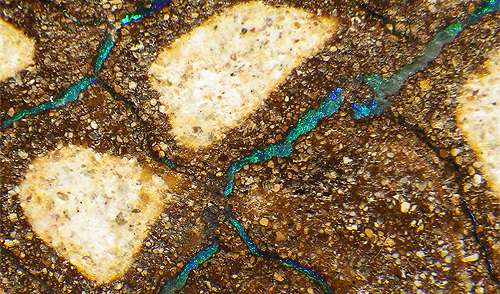Answer to opal mystery shows Red Centre's links to Red Planet

(Phys.org) —The dramatic geological events that created opal, Australia's national gemstone, have been described for the first time by a University of Sydney researcher.
The explanation underlines how the geology of Australia's Red Centre is the most similar on Earth to the geology of Mars, to the extent it could yield valuable information on that planet for a fraction of the cost of a space mission.
"Australia produces over 90 percent of the world's supply of opal. Before this we did not know its origin, why it forms at such shallow depths or why it can be found in central Australia and almost nowhere else on Earth," said Associate Professor Patrice Rey, from the University's School of Geosciences.
His findings have recently been published in the Australian Journal of Earth Sciences.
"The formation of Australian opal was due to an extraordinary episode of acidic weathering, during the drying out of the central Australian landscape," said Associate Professor Rey.
This occurred when the Eromanga sea, a vast body of water covering 60 percent of Australia, extending from Coober Pedy to the Carpentaria Basin and across to Lightning Ridge, started retreating.
Between 100 million and 97 million years ago this sea came to cover a much smaller area. This meant the previously inundated central Australian landscape started drying out and acidic weathering happened on a massive scale when pyrite minerals released sulphuric acid.
Acidic weathering of the type that took place in Central Australia is unique on Earth at that scale, covering an estimated 1.3 million km2, but it has been described at the surface of Mars.
"The USA and the European community have invested billions of dollars to send orbiters and rovers to Mars in the hope of finding extra-terrestrial life but Central Australia offers a unique natural laboratory where potential Martian bio-geological processes could be studied."
Notably, opaline silica, iron oxides and clay minerals similar to those found in central Australia were discovered at the surface of Mars in 2008, where they were interpreted as the product of acid weathering of volcanic debris covering the red planet.
"Many Australians familiar with the unmistakable features of Australia's Red Centre may not realise, despite their similarly striking red appearance, that it shares many of its remarkable characteristics with Mars, which also appears to be why opaline silica forms there."
To create the precious opal found in Australia, as opposed to opaline silica, demands a switch to alkaline conditions before silica-rich gel trapped in fractures and cavities dehydrates and solidifies. This is only possible when the host rock, as in Australia, has a large acid-neutralising capacity.
The opal discovery is personally satisfying for Associate Professor Rey who first encountered Australia as a schoolboy in France, through a 1970s documentary on opal mining in Coober Pedy. Thirty years later the Lightning Ridge Opal Miners Association reconnected Patrice with his childhood memory when they rang to ask him about researching the origin of opal.
Provided by University of Sydney




















